序章
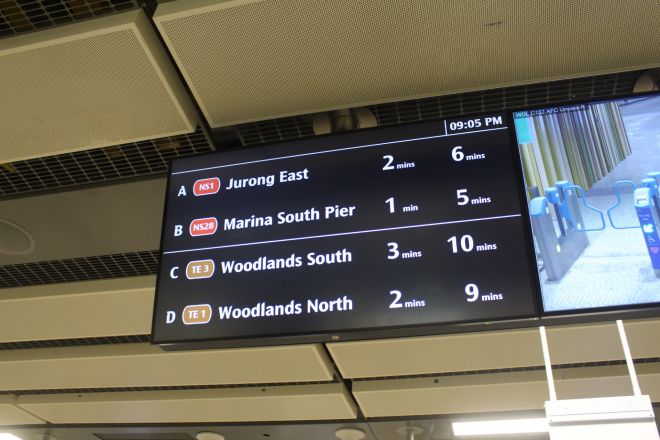
With the acceleration of modern urbanization, the subway system, as the aorta of urban transportation, plays an increasingly important role in people’s daily lives.
In this era of information explosion, how to efficiently and intuitively transmit information and improve the travel experience of passengers has become an important topic of subway station design and management.
LED表示, as an advanced display technology, plays an irreplaceable role in the information dissemination of subway stations with its advantages of high brightness, high definition, and low energy consumption.
From simple line instructions to complex interactive queries, from real-time operation announcements to rich commercial advertisements, the LED display screen has injected new vitality into the information dissemination of subway stations with its diversified forms and powerful functions.
1. What are the benefits of using LED displays in subway stations?
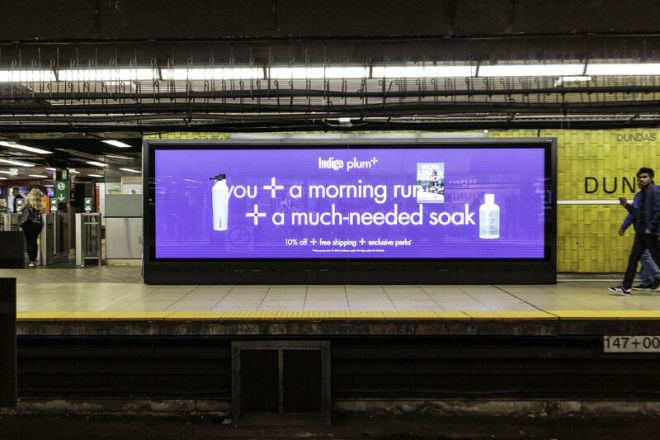
1). Benefits for passengers using LED displays in subway stations:
- It is more convenient to obtain information
The LED display can update and display subway lines and stations, as well as transfer information and operation announcements in real time. By looking at these display screens, passengers can quickly understand the real-time operation of the subway, including key information such as train arrival time and station changes.
This not only reduces the risk of passengers missing the train or going in the wrong direction due to incomplete information or outdated information but also greatly saves their time in finding information or consulting staff in the subway station.
- The travel experience is more comfortable
The LED display screen not only provides basic line and site information but also provides practical information such as weather forecasts and news information, providing more convenience for passengers to travel. In addition, the LED display screen of some subway stations also has an interactive function.
Passengers can query more detailed information or perform ticket operations through the touch screen. This intelligent service method makes passengers’ travel experience more comfortable and convenient.
- Richer culture and entertainment
In addition to providing practical travel information, the LED display screen can also play various cultural promotional videos, public service advertisements, and entertainment content, providing passengers with a colorful visual experience when waiting for the train or changing trains.
This not only helps to relieve the waiting anxiety of passengers but also enhances the cultural atmosphere and brand image of the subway station.
2). Detailed analysis of the benefits of using LED displays in subway stations:
- Improve the efficiency and accuracy of information transmission
The LED display has the characteristics of high brightness, high definition, and bright colors, which can quickly attract the attention of passengers and clearly display all kinds of information.
Whether it is line instructions, site information, or real-time operation announcements, the LED display can be presented in an intuitive and easy-to-understand way so that passengers can quickly obtain the required information and improve travel efficiency.
- Improve the intelligence level of subway stations
As an important part of the intelligent construction of subway stations, LED display screens can realize the connection with the central control system and realize the remote update and management of information. This not only improves the operational efficiency of the subway station but also reduces labor costs.
At the same time, through data analysis and intelligent management, subway stations can more accurately grasp passenger needs, optimize service processes, and improve the overall operation level.
- Promote cultural communication and commercial promotion
As a crowded public place, the subway station is an important platform for cultural communication and commercial promotion. The LED display screen can play all kinds of cultural promotional videos, public service advertisements, etc., to enhance passengers’ cultural literacy and sense of social responsibility.
At the same time, through the launch of advertising LED displays, merchants can display brand images and product information in subway stations to attract potential consumers and maximize commercial value.
2. What are the types of LED displays used in subway stations?
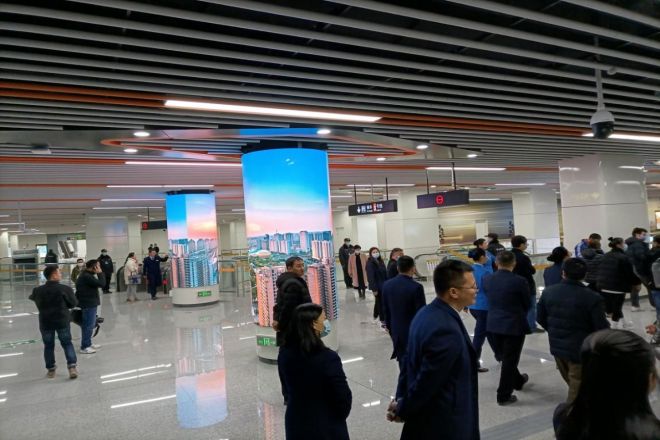
The types of LED display screens used in subway stations are indeed rich and diverse. The following are some common LED display screen types, paying special attention to indoor fixed LED display screens and other types:
This is a traditional conventional LED display, which is usually used in indoor environments. The screen size is the same, the one-piece molding is not deformed, and the error is small, which can provide a stable and high-quality display effect.
They are usually installed in fixed locations in subway stations, such as walls or columns, to display subway maps, station information, announcements, etc.
This display is characterized by its flexibility of repeated disassembly and installation. The screen body is ultra-light, ultra-thin, and space-saving. It can be spliced in any direction, size, and shape to meet the display needs of various temporary or special occasions. In subway stations, they may be used for publicity and display of temporary events or special events.
This is a display screen with ultra-small spacing and high pixel density, which can present a more delicate and clear picture. In the subway station, they can be used for high-definition video playback, advertising display, etc., to provide passengers with a richer visual experience.
The design of the transparent screen enables the display screen to display content while maintaining a certain degree of transparency. This design is not only beautiful but also reduces the occlusion of space. It is especially suitable for glass partitions, windows, and other subway station locations.
- LED creative display:
This kind of display is based on innovation and creativity, with a variety of shapes and designs, such as LED cylindrical screens, spherical LED displays, etc. They can attract the attention of passengers and add a unique artistic atmosphere to the subway station.
In addition, there are LED monochrome displays, LED dual-color displays, and LED full-color displays, which can meet different information display needs according to different color performances.
The application of these LED display screens in subway stations not only improves the efficiency of information transmission but also provides passengers with a more comfortable and convenient travel experience.
At the same time, they also enrich the visual landscape of the subway station and enhance the beauty of the overall environment.
3. Application scenarios of LED display in subway stations
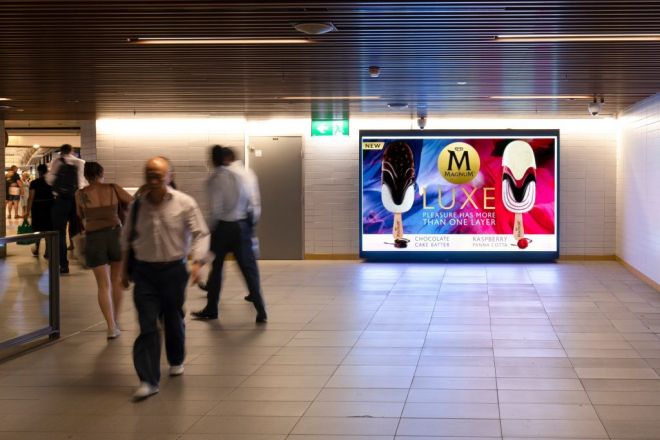
The installation location of the LED display in the subway station is indeed detailed and diverse. The following is a further detailed description of its installation location:
- Channel and workshop tunnel walls:
In these places, LED display screens are usually installed on walls or tunnel walls to display relevant information about the operation of the train, such as the station where the train is about to arrive, the direction of operation, etc.
These displays are usually designed to be eye-catching so that passengers can quickly capture the required information while walking or waiting. In addition, their size and resolution are usually optimized according to the installation location and traffic to ensure the clarity and readability of the information.
- Platform layer:
On the platform layer, the installation location of the LED display screen may be more diverse. Some are installed on the top of the platform and adopt a suspended or embedded design to provide a larger viewing angle and better visual effects.
These display screens are often used to display train arrival times, transfer information, and various announcements to help passengers better arrange their trips. In addition, the platform layer may also be equipped with some column or wall-mounted LED displays to broadcast advertisements or provide other value-added services.
- Import-export and transfer channels:
In these areas, the installation position of the LED display usually takes into account the flow of people and the viewing angle. They may be installed above or on the side of the entrance and exit to attract the attention of passengers and provide convenient information viewing.
The display screen in the transfer channel may be set along both sides or at the top of the channel to provide passengers with clear transfer guidelines and relevant information.
- Waiting areas and public areas:
Waiting areas and public areas are places where passengers stay for a long time, so the installation of LED displays is usually more diversified and rich. They may be installed above the seats, walls, or columns in the waiting area to provide passengers with real-time news, weather forecasts, and other practical information.
The display screen in the public area may pay more attention to commercial value and advertising effects, and it is installed in a conspicuous position to attract the attention of passengers.
In addition to the above common locations, the LED display screen in the subway station may also be customized and installed according to actual needs. For example, during special events or festivals, subway stations may set up temporary LED displays to create an atmosphere or provide relevant information.
When installing the LED display, it is also necessary to consider the coordination and aesthetics of the overall environment with the subway station. The design, color, and brightness of the display screen should match the decoration style and lighting conditions of the subway station to ensure the consistency and comfort of the overall visual effect.
4. Are there LED display screens in other transportation places besides subway stations?
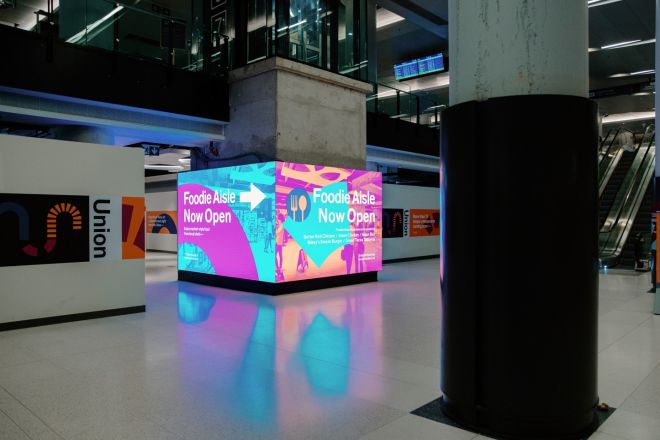
Of course, in addition to subway stations, LED display screens are also widely used in other transportation places.
初めに, in the field of buses, LED display screens are used to provide real-time bus information. By connecting to the city’s traffic monitoring center, the LED display can update the arrival time and route information of the bus in real-time to help passengers plan their travel more effectively.
加えて, the LED display can also be used to display advertising content, provide publicity opportunities for advertisers, and also bring additional revenue to the public transportation system.
第二に, LED displays play an important role in airports. They are not only used to display flight information, boarding gate prompts, etc., but also to publicize, display the image of the airport, and carry out scheduling work.
Through the LED display screen, the airport can realize control of the whole region and the whole process and improve operation management efficiency.
加えて, LED display screens also play an important role in railway stations, ports, and other traffic nodes. They are mainly used to display traffic instructions, road condition information, flight information, etc., to help passengers and vehicles run according to the specified routes and ensure smooth and safe traffic.
結論
The above is the whole content of this article. If you still have questions about the LED display, お問い合わせください.
